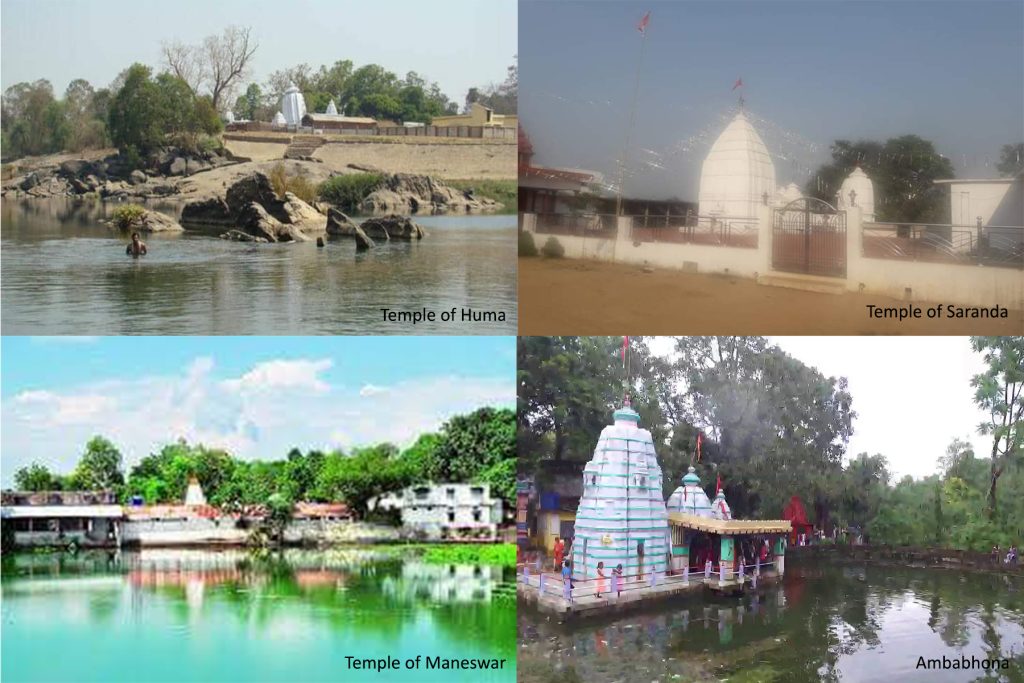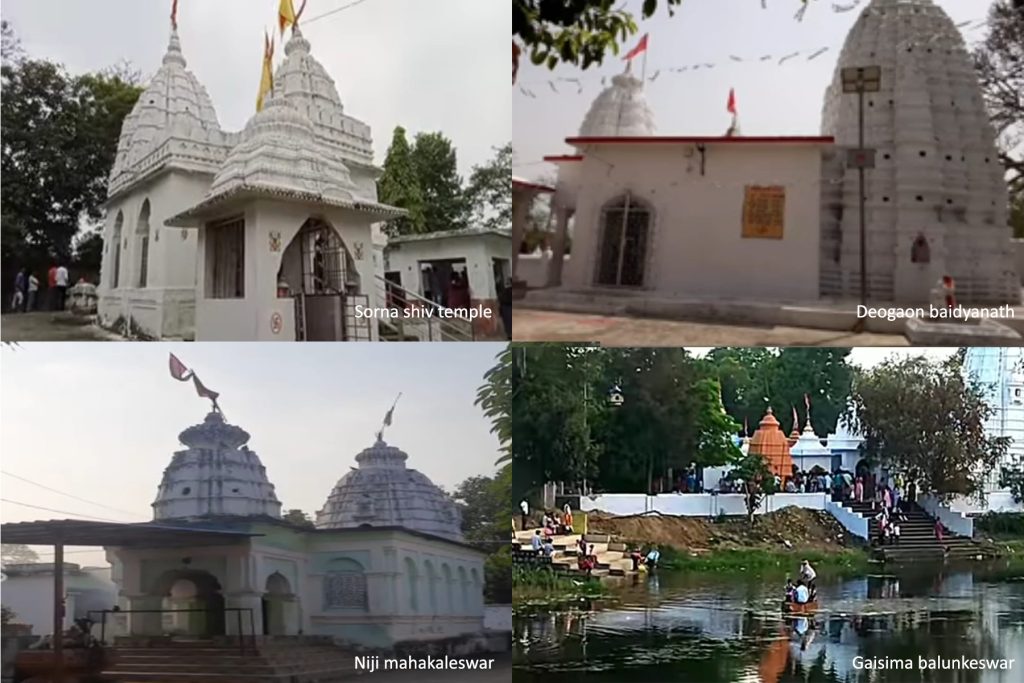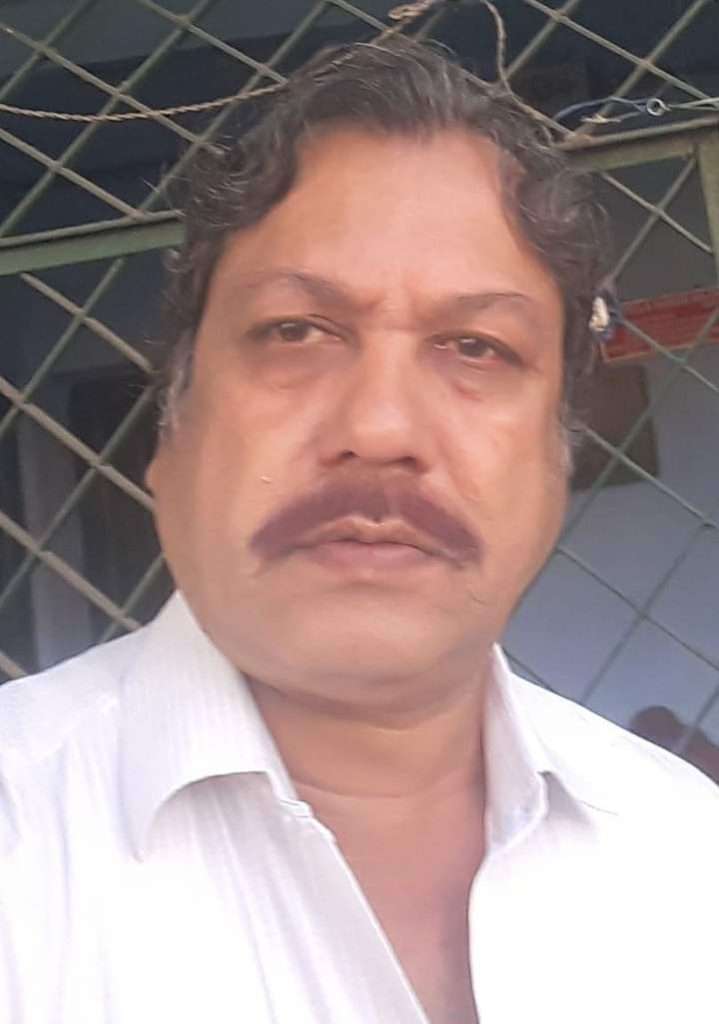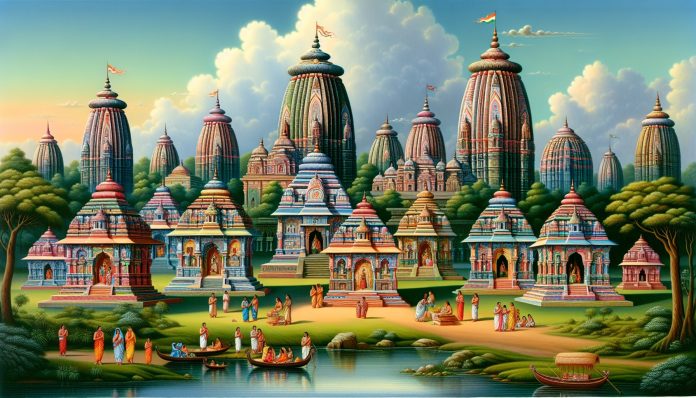Saivism is one of the most popular cults within the Hindu fold. From Amarnath to Rameswaram and from Kedarnath to Bheemashankar the popularity of Lord Siva is unparalleled. People have got deep religious faith in the power and benevolence of Lord
Siva Who is also called ‘Ashutosha’ for His being easily appeased. Like India and Odisha
western Odisha does not lag behind in the matter. Saivism is not only very old but also
popular in the region. There is the presence of ‘Ashtashambhu’ mainly confined to the districts of Sambalpur and Bargarh.
Legend has it that Baliar Singh Dev, the fifth Chauhan king of Sambalpur along with his queen one fine morning found their minor son missing from the bed. They were very
much worried and not finding him anywhere around sent the royal soldiers in all directions on the look out for him. After a few days he was traced sitting under a tree in a jungle.
He was brought to the palace and on inquiry by the king he said that while sleeping with
them at night eight ‘Babas’ appeared and invited him to eight places which he visited. Then they gave the message that the king of Sambalpur would build eight temples on the sites that he had visited with the ‘Babas’. The king could understand what his son wanted to convey and decided in favour of the construction of eight temples which have turned out to be the ‘Ashtashambhu Peethas’ of western Odisha. Dakshinray, the Dewan of the kingdom of Sambalpur during the reign of king Ajit Singh is reported to have completed the
construction of the temples out of funds collected as pecuniary punishment imposed
on the people.Out of the eight temples six are in the district of Bargarh while two are in the district of Sambalpur. Earlier all the temples were in undivided Sambalpur district.
Regarding the appearance of ‘Ashtashambhu’ in western Odisha there is another legend. Once Lord Siva and Mata Parvati were returning to Kailash from the court of Devaraj Indra who had invited them as guests. While up in the sky over western Odisha Lord Siva was enamoured of the scenic and natural beauty of the area and cherished the desire of settling down over here. Accordingly he extracted eight ‘jatas’ from his head and threw them down. The ‘jatas’ fell on eight places and appeared as ‘lingas’ where eight temples have been constructed subsequently. It is said,where there is Siva,there is Shakti.Agreeing with Lord Siva’s desire to settle down over here Maa Parvati also decided to follow suit and threw down seven petals from the ‘parijata ‘ flower that Devraj Indra had presented to Her.The petals fell on seven places where she appeared as Sapta Chandi. The seven Peethas are of Maa Samaleswari, Maa Sureswari, Maa Manikeswari, Maa Ghanteswari, Maa Metakani,
Maa Chandrahasini and Maa Pataneswari.
The speciality of ‘Ashtashambhu’ is that all the Lingas are ‘Ubhalinga’ appearing on their
own and not manmade. It is believed that all the temples were founded on the same day by King Baliar Singh Dev of Sambalpur and the king covered all the places in one day riding on horse back from one temple to another. All the places are known for their rural backdrop and scenic beauty. The temples are small in height and follow the prevalent architectural style of the area. For temple management and ‘Bhogaraga’ the king had provided cultivable land and ‘Thanapati’ priests were appointed to worship the deities from generation to generation. Just as a similar tradition in portions of coastal Odisha non-Brahmin priests of ‘Thanapati’ community were assigned the job. It is believed that since Lord Siva has been in existence since the olden times even before the Aryan civilisation His worship would be befitting in the hands of ‘Thanapati’ priests. Since then the tradition has continued in western Odisha.On the contrary the tradition of Brahmin priests worshipping in the Vaishnava temples has continued. The tradition of the Saiva cult can also be found in the Shakti or Devi temples of the area. The eight places where Lord Siva is worshipped as ‘Ashtashambhu’ are as follows;
1)Huma-Approximately twenty-five kilometres from the city of Sambalpur adjacent to Sonepur-Sambalpur highway stands the Huma village with a temple on one bank of the river Mahanadi.Legend has it that before the temple was built by King Baliar Singh Dev of Sambalpur(1650-1688AD)a black cow was pouring milk on a rock which later turned into a Linga and came to limelight. Lord Siva is worshipped as Baba Bimaleswar Mahadev over here.The Mahanadi ghat adjacent to the temple is known for a kind of fish called ‘kudo’which accept sweets from the devotees. Nobody tries to catch or kill the fish. Legend has it that anybody trying to do so will turn to stone.They are even called by names,’Sunapindhi’,’Gunapindhi’ etc. it is believed that the fish are dear to the God and take shelter inside the temple coming through a tunnel in rainy season. The temple is a leaning one often being compared to the leaning tower of Pisa. The whole temple complex including the boundary is leaning. The main temple and other temples have tilted in different directions. Tectonic movement of the riverside soil,natural construction from its inception and a curse from the Lord are the different reasons often ascribed to the leaning nature of the temple. Shivratri is the main festival over here and on the occasion a fair is held for over a week every year. This fair has been the hub of marketing activities in the area since long.

2)Maneswar-The village with a temple on one bank of the river Malati is approximately
ten kilometres from the city of Sambalpur. The temple is dedicated to Lord Siva as Mandhata Baba. There is a large pond adjacent to the temple which harbours tortoises. Devotees feed sweets to the tortoises.The pond is as old as the temple which was dug for use and the tortoises are called ‘kechho baba’ and ‘bhog’ is offered to them immediately after it is offered to the Lord. It is believed that they never die and some are even as old as one hundred and fifty years. They are considered to be the ‘Kurma Avatar’ of Lord Vishnu.Recently a promontory has been constructed extending midway into the pond for viewing the large tortoises which have been the main attraction for the devotees and tourists. Shivratri is the main festival over here. Legend has it that king Baliar Singh Dev of Sambalpur was a staunch devotee of Baba Bimaleswar of Huma. Once he could not visit the temple due to floods in the Malati river and had to remain on fast.On the night the Lord appeared in his dream and directed him to construct a temple at Maneswar for His worship.There were dense jungles in the area and the king was directed to locate the spot where a black cow would be pouring milk.By that time there was no Siva temple in and around Sambalpur. Since He fulfilled the wish of the king He has been called Mandhata Baba.The name of the village is also believed to have been derived from the Lord. The temple is small in height but boasts of the Chauhan architecture with great artistic beauty.The temple being one of the oldest near the city of Sambalpur with a picturesque background was clearly visible from the nearby bridge on Sambalpur- Cuttack highway earlier. But now a new bridge has been constructed and the road has been diverted a little.Moreover large trees behind the temple camouflage it.
3)Saranda-It is a small village on Sambalpur- Bargarh highway pitted against a scenic
background of greeneries and green fields. It is twenty-five kilometres from the town of Bargarh. The temple was built under the supervision of Dewan Dakshinray during the rule of king Ajit Singh of Sambalpur(1725-1766AD). Before the temple was built the Lord was being worshipped in a cottage.Legend has it that when Dewan Dakshinray was riding on horseback his horse could not move any further and stopped over here.Then the Lord directed the king to construct a temple and worship Him. It is the third temple in a row of eight temples called ‘Ashtashambhu Peethas’. The temple is different in structure from the other temples.Lord Siva is worshipped as Bisweswar Baba over here. Almost midway between Sambalpur and Bargarh the temple is clearly visible from the highway and is in the district of Bargarh. Shivratri is the main festival over here.There is a huge pond adjacent to the temple covering an area of two acres approximately and is known for its beautiful and colourful fish.
4)Sorna-The village with a temple stands at a distance of thirty-five kilometres approximately from the town of Bargarh. Lord Siva is the presiding deity of the place.The temple dedicated to Baba Swapneswar was built during the kingship of Ajit Singh of Sambalpur and under the supervision of Dewan Dakshinray.Legend has it that the Gountia of Sorna village being a staunch devotee of Lord Siva used to visit Huma for His darshan regularly after crossing the river Mahanadi. One day Lord Siva tried to test his ‘bhakti’ and made the river overflow. But the Gountia continued to cross the river till water reached neck high. Then Lord Siva appeared before him in the guise of a Brahmin and asked him to go back to his village and search for the place where his black cow would be pouring milk. He deployed persons to dig the place on a hillock with tamarind trees around. With no result he himself started digging and when his weapon pounced upon the ‘linga’ two flows of milk and blood came out of it. Then the Lord appeared in his dream and directed him to start worship. He is called Baba Swapneswar since He appeared in his dream. The temple was later built by the king of Sambalpur. There is a huge pond in front of the temple covering an area of six acres.The temple itself covers an area of four acres.There are two routes to the temple,one through Rengali Camp and the other through Remunda.Shivratri is the main festival over here.
5)Neelji-Neelji is a small village approximately eight kilometres from Bhatli and twenty-two
kilometres from the town of Bargarh. Lord Siva,the presiding deity of the place is called
Mahakaleswar. Legend has it that Lord Siva incarnated as Mahakaleswar during the reign
of Balaram Dev(1570-1595AD),the first Chauhan ruler of Sambalpur. The Lord is also called Neelkantheswar. Legend has it that one of Balaram Dev’s cows was coming over to the spot from nearby Nuagarh after crossing the river and pouring milk over the Linga.When scolded by the king one day as there was shortage of milk for the calf the cowherd followed the cow and saw her pouring milk. When the Lord saw the cowherd He got angry and destroyed his whole family. Then Balaram Dev realised that Mahakaleswar had appeared there and named Him so. It is believed that the Linga is slightly broken either by the stick of the cowherd or when the feet of the cow struck it on being beaten by the cowherd. Subsequently the temple was constructed in the place. There is a pond adjacent to the temple.
6)Gaisama-The village is thirteen kilometres approximately from the town of Bargarh. The temple is dedicated to Baradabalunkeswar and was built during the rule of king Abhaya Singh of Sambalpur during the years 1766-1778AD. Legend has it that the Gountia of Gaisama was a staunch devotee of the Lord and worshipped the Linga. Once the king of Sambalpur visited the shrine. The priest offered him a ‘belpatra’ and the king found a hair in it. The king got angry with the priest and promised to look into the matter and punish him on his way back. The priest prayed to the Lord to save his life. On return the king found a long ‘jata’ around the Linga. Getting further angry with the priest he tried to pull out the ‘jata’ but found two pieces of hair stained with milk and blood. The king realised his mistake and immediately ordered the construction of a temple over there. Shivratri is the main festival over here. It is an ancient shrine situated on the bank of the river Jira. There is a beautiful pond adjacent to the temple where tortoises can be seen.
7)Ambabhona-At the foot of Barapahar mountain the village is fourty kilometres approximately from the town of Bargarh. The temple dedicated to Baba Kedarnath is inside
a beautiful pond and speaks highly of Chauhan architecture. According to a popular belief it was built during the reign of King Baliar Singh Dev of Sambalpur. But history says that it was constructed under the supervision of Dewan Dakshinray during the rule of king Ajit Singh. Legend has it that a black cow from the Gountia family of a village on the other side of the river used to cross it and poured milk on the spot where the temple stands now. On detection attempt was made at constructing a temple and worshipping the Lord over here.
Shivratri is the main festival over here.The temple is adjacent to the river Mahanadi.

8)Deogaon-Just ten kilometres approximately from the town of Bargarh the village has the temple dedicated to Baba Baidyanath. Legend has it that a black cow was pouring milk on a particular place regularly. One day the cowherd could see it and got angry. He started digging the place and found out a statue of Nandi. It is because of this reason that the Nandi here has a lot of dents. Whatever items could be found during excavations have been stored in the temple complex. Here the Sivalinga is one foot below the surface level. History says that the temple was built by King Ajit Singh of Sambalpur under the supervision of his Dewan Dakshinray.Shivratri is the main festival over here. There is a beautiful pond adjacent to the temple and the background is very scenic. The temple is small in height but speaks highly of Chauhan architecture.
A study of history along with the myths and legends makes it probable that worship of
Lord Siva in the eight places was in vogue by the local people before the Chauhan kings of
Sambalpur appeared on the scene.Since it may not be possible for a single king to construct all the temples during his reign due to one reason or the other successive kings seem to have taken interest in the construction of the temples keeping in mind popular faith ,myths and legends. The credit for the Kedarnath temple of Ambabhona going to two persons is a case in point. It may have so happened that King Baliar Singh Dev might have started the construction and later Dewan Dakshinray might have renovated, remodelled or constructed it a new entirely. In history it so happens that construction works,remodelling and renovations etc. are carried on from one king to another. The popular belief that King Baliar Singh Dev founded and visited all the eight temples in one day on horseback is another case in point. Temples and mode of worship might have existed in one form or the other which have been developed further by the successive kings. The legend that king Balaram Dev,the first Chauhan king of Sambalpur named Lord Siva of Neelji as Mahakaleswar makes it clear that the shrine did exist even before king Baliar Singh Dev and king Ajit Singh appeared on the scene.The popular belief that king Ananga Bhima Dev III had visited Huma for worship of the Lord to cure himself of a fatal disease makes it clear that the Lord did exist there before Baliar Singh Dev constructed the present temple. Anangabhimadev III(1211-1238AD) is believed to have built the first temple at Huma in the early thirteenth century and Baliar Singh Dev rebuilt it from its ruins in the seventeenth century. Popular beliefs,myths and legends are often deep rooted and carry a lot of
weight in our country where people have got strong religious feelings and faith. Slight variations can also be seen in the popular beliefs,legends and myths. Though historians and researchers take into account various sources as evidence these often come in their way and even get mentioned as required.
A visit to the ‘Ashtashambhu Peethas’ followed by a close study of history, the myths
and legends brings to mind certain similarities amongst the Peethas.Firstly,a myth or legend exists regarding the origin of the deities in each place.Secondly,all the temples have been built during the Chauhan regime of Sambalpur in the prevalent style of temple architecture with minor differences here and there. There are water bodies adjacent to
the temples. Except for Huma Bimaleswar which is situated on one bank of the river
Mahanadi there are beautiful ponds near the rest of the temples.Water available nearby is not only used for cooking ‘bhog’ but also for ‘jalabhishek’. In Huma,Maneswar,Saranda and Gaisama the river and ponds harbour fish and tortoises. The most striking similarity
amongst the Peethas is their existence in a backdrop of natural and scenic beauty.
Festivals like Shivratri are also common to all the shrines.Since the Peethas have great
religious significance and picturesque beauty with devotees flocking tourism has good
prospects in all of them.
Just as twelve ‘jyotirlingas’ are spread across the country so also are the eight ‘ashtashambhus’ in western Odisha. Saivism is extremely popular in western Odisha and these eight temples hold a special place in the psyche of the devotees and have been instrumental in creating a spiritual atmosphere in the region. These have also greatly enriched the art,architecture and culture of the area. Shivratri is the main festival in these Peethas and devotees flock to these with the hope that Bholebaba
would bless them and fulfill all their desires.
(The views expressed are the writer’s own)

Mr. Prafulla Kumar Majhi,
Retd. Asst. Director(P), All India Radio.
He is an eminent Scholar and freelance writer in English & Odia. His areas of interests are sociocultural, economic, literary, historical and analytical studies and writings.

